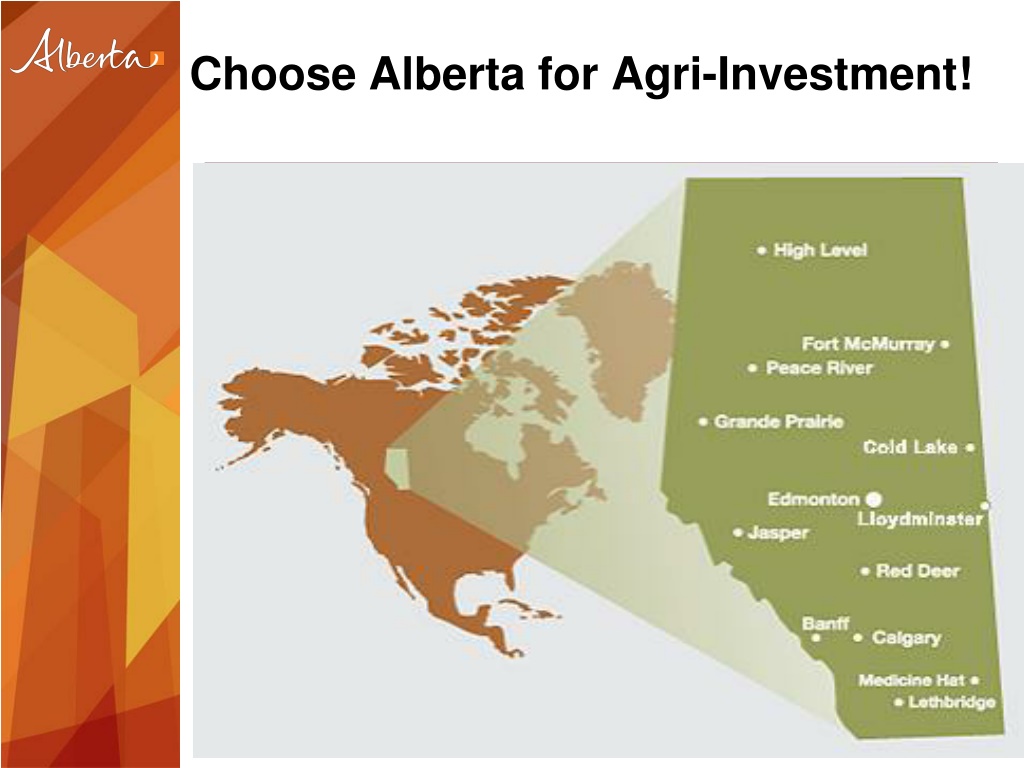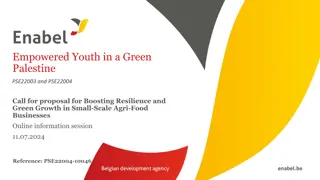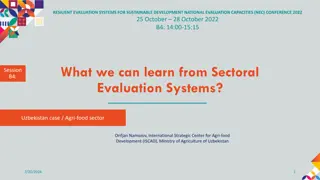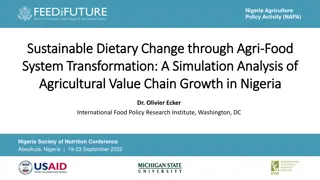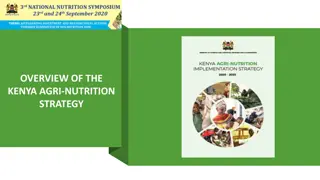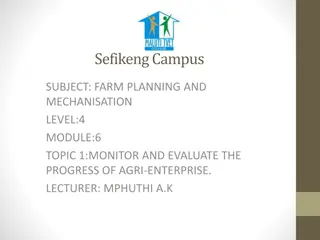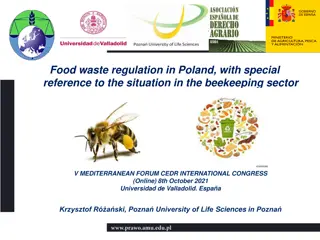Invest in Alberta's Thriving Agri-Food Sector
Alberta offers a competitive business climate with low taxes and costs, making it a prime location for agri-investment. The province boasts a robust agri-food sector, providing a reliable supply of commodities and a strong reputation for high-quality agricultural products. With easy access to global markets and funding programs available, Alberta is an ideal choice for agri-investment opportunities.
Download Presentation

Please find below an Image/Link to download the presentation.
The content on the website is provided AS IS for your information and personal use only. It may not be sold, licensed, or shared on other websites without obtaining consent from the author. Download presentation by click this link. If you encounter any issues during the download, it is possible that the publisher has removed the file from their server.
E N D
Presentation Transcript
Table of Contents I. II. III. IV. V. VI. VII. Important Links VIII. Contact Information Alberta has a Competitive Business Climate A Robust Agri-Food Sector Innovative Research and Development Easy Access to World Markets Efficient Transportation and Logistics Funding programs 2
ALBERTAS COMPETITIVE BUSINESS CLIMATE 3
According to KPMG: Canada has the Lowest Location Costs among G7 Economies Canada s Business Costs Compared to the United States 14.6% And Alberta s agri-processing manufacturing costs are 9.5% lower than in USA. Source: KPMG s Guide to International Business Location Costs, 2016 edition. Data Retrieved on April 1, 2016 from: https://www.competitivealternatives.com/reports/compalt2016_report_vol1_en.pdf 4
Competitive Tax Environment Alberta businesses have among the lowest business taxes in Canada due to: Low corporate tax rates No provincial retail sales tax No capital tax No provincial payroll tax 5
Alberta a Reliable Supplier of Commodities Alberta s reputation as a world- class producer of agricultural commodities and agri-food products is the cornerstone of its strengths in agri-food production. Alberta's Crop Production 2016 (metric tonnes) Wheat, all 9,898,200.00 Wheat, all excluding durum wheat 8,314,300.00 Tame hay 7,819,900.00 Canola 5,783,300.00 Barley 4,398,000.00 Alberta enjoys a global reputation for safe, high-quality agriculture and agri-food products. Peas, dry 2,271,200.00 Corn, fodder 1,542,200.00 Sugar beets 725,700.00 Oats 624,600.00 Lentils 506,200.00 The reputation stems from accurate and consistent grading systems for grains and oilseeds, and various food safety initiatives for producers, processors, and consumers. Mustard seed 71,600.00 Corn for grain 63,500.00 Beans, all dry (white and coloured) 54,700.00 Flaxseed 54,600.00 Fababeans 54,400.00 Rye, all 49,500.00 Mixed grains 24,900.00 Triticale 19,600.00 Type of crop 2016 7 Source: Statistics Canada, CANSIM Table 0010010
The Agri-Food Industry is one of Alberta s Main Economic Drivers https://encrypted-tbn3.gstatic.com/images?q=tbn:ANd9GcSp93U3kCROWUtNGE6vAhXYqwc7UbddfyHD3Utn2bUN7V4eUGyM Alberta s real GDP for Agri-Food Industries in 2016 Alberta s agri-food industry in 2016 Food and beverage processing largest Alberta manufacturing sector by revenue/sales $14.6 billion in manufacturing sales, 22,400 jobs (50,800 in primary agriculture) $5.0 billion in exports of processed products. 40,638 farms operate in Alberta (50.3 M acres of farmland) in 2016 Alberta's food and beverage manufacturing sales totaled a record $14.6 billion in 2016. Alberta is home to 671 Agri-food companies 7 Source: Statistics Canada CANSIM # 379-0030; Census of Agriculture, and Industry Canada
A Growing Agri-Food Industry ALBERTA'S FOOD AND BEVERAGES MANUFACTURING SALES 16,000,000 25% 14,000,000 20% 12,000,000 10,000,000 15% 8,000,000 10% 6,000,000 4,000,000 5% 2,000,000 - 0% 2006 2007 2008 2009 2010 2011 2012r 2013r 2014r 2015r 2016p Food and Beverages Manufacturing Sales as a % of total manufacturing sales
Albertas Agri-Food Industry is Export-Oriented Alberta is the third largest exporter of agri-food products in Canada after Saskatchewan and Ontario. In 2016, Alberta s agri-food exports reached $9.9 billion. Main products 2016 (46.7% of total agri-food exports): canola seed ($1.8 B), wheat (1.8 B), beef: fresh, chilled, frozen, incl. ofal (1.7 B), live cattle (excl. purebred) (623 M), crude canola oil (558 M) Alberta Agri-Food Exports Top 10 Partners (2016) Bangladesh 2% United Arab Emirates 2% Indonesia 2% Hong Kong 2% Pakistan 3% Korea, South 3% Mexico 6% United States 48% Japan 15% China 17% 10 Source: Statistics Canada Data prepared by: Statistics and Data Development Branch, Economics and Competitiveness Division, Alberta Agriculture and Forestry April 20, 2017; and Industry Canada Trade Data Online.
Sub-sector Strengths/Niche Areas Business Environment Alberta is home to 671 food processing companies of which over 200 are FF/NHP-related; over 48 core FF/NHP Over 90% are located in Edmonton and Calgary 10% are located in Lethbridge, Red Deer, Olds and rural Alberta Business Strengths product formulation finished products, functional food or ingredients raw ingredient producers bioactive extraction analytical testing Many companies are active in more than one area 9
INNOVATIVE RESEARCH AND DEVELOPMENT
Alberta has over 22 research and innovation facilities which specialize in such areas as crops and cereals, poultry and swine research, agronomy, biomaterials and food safety. 13
The Food Processing Development Centre Agriculture and Forestry has a 6,000 square metre Food Processing Development Centre in Leduc which includes the Agrivalue Processing Business Incubator, a food product commercialization facility that is unique in Canada. FPDC is undergoing a $10 M expansion that will add 2,300 sqm 12
Canada and Alberta have very generous tax incentives to conduct research and development. Canada currently offers one of the most favorable tax treatments for R&D among the G7 Canada provides a system of tax credits and accelerated tax deductions for a wide-variety of R&D expenditures Eligible costs include: salaries, overhead, capital equipment, and materials The Alberta Scientific Research and Experimental Development (SR&ED) tax credit benefits businesses of all sizes and in all sectors that conduct research and development that will lead to new, improved or technologically advanced products or processes. The credit is worth 10 per cent of a company's eligible expenditures up to $4 million, for a maximum credit of $400,000. It will be refundable for all companies. Relative Generosity of R&D Tax Treatments* (Index: Canada = 100.0) France 123.9 Canada 100.0 Japan 85.9 U.K. 84.0 U.S. 80.6 Italy 77.0 Germany 76.1 50 60 70 80 90 100 110120 130 Source: Warda, Jacek, Innovation: Measuring Canada's R&D Tax Incentives: May 22, 2009. Data unchanged as of January 2012. Note: Relative generosity is determined by dividing the after tax cost of performing $1.00 of R&D by 1 less the corporate tax rate. Results are indexed to the relative generosity of Canada's system of tax-based support for R&D. The higher the ratio the more competitive the tax system. * Calculations based on large firms 15
EASY ACCESS TO WORLD MARKETS 16
Excellent global market access for business With the Canadian-European Union Comprehensive Economic and Trade Agreement (CETA) firms operating in Canada have preferred market access to 42 foreign countries. Canada s preferred market access represents approximately 1.2 billion consumers and nearly US$41.2 trillion or 54.8%, of global GDP. Canada s market access is supported by a reliable and efficient transportation system, providing for effective Canadian business participation in global supply chains. Source: IMF World Economic Outlook April 2017/Think Canada presentation 2017
EFFICIENT TRANSPORTATION AND LOGISTICS
Efficient road, air and rail infrastructure Alberta is well connected by road, air, and rail. Edmonton and Calgary international airports are among the busiest in Canada and offer 24-hour cargo services, modern cargo terminals and U. S. pre-clearance facilities. Alberta s 30,800 km of provincial highways connect CANAMEX, a 6,000-kilometre corridor stretching from Alaska to Mexico as well as to two transcontinental railways companies, the Canadian National (CN) and the Canadian Pacific Rail (CPR). Rail terminals strategically link Edmonton and Calgary with international ports on the west coast (Vancouver and Prince Rupert), the Great Lakes (Thunder Bay and Toronto), the St. Lawrence Seaway (Montreal), and the east coast (Halifax). 19 Source: map extracted from http://www.cpr.ca/en/choose- rail/intermodal-shipping
Alberta Offers Investors Easy Access to Fast Growing Markets in North America and Asia The Prince Rupert Grain Terminal (PRGT) is located in the Port of Prince Rupert. PRGT is jointly-owned and operated by Viterra, Cargill, and Richardson. Prince Rupert Grain Terminal is closer to Asian markets by 36 hour sailing time compared to other pacific ports. Annual Throughput Capacity: 7 million tonnes Storage Capacity: 202,000 tonnes Ship Loading Rate: 4,000 tonne/hour Single berth depth: 14.5 m (low tide) Ship size limit: 145,000 DWT (Suezmax) On- terminal rail trackage: 17 km 20
Albertas Twelve International Offices United Kingdom China - Beijing Alberta Korea Office Washington, DC Alberta China Office Alberta Shanghai Office Korea Alberta India Office Shanghai Guangzhou Alberta Singapore Office India Japan Mexico Taiwan Hong Kong Singapore 21
Select Funding Programs Alberta Capital Investment Tax Credit (CITC) The CITC is a 2-year program that provides a non- refundable tax credit valued at 10% of a corporation s eligible capital expenditures, up to $5 million. The CITC encourages companies to make timely capital investments by returning a percentage of the company s costs, including the purchase of machinery, equipment and buildings. https://www.alberta.ca/capital-investment-tax-credit.aspx The Work Force Development Program at Alberta Agriculture and Forestry (AF) provides assistance to address specific workforce issues in agricultural production and agri-processing activities. The Productivity Improvement Grant provides assistance to agri-processing companies to assess and adopt new technologies, processes and training that improve worker productivity. The Retention Grant provides assistance for employers to contract consultants to review, improve and develop retention strategies in order to reduce worker turnover and address workforce stability. AF will fund 50% of eligible activities to a maximum of $25,000. The Canada-Alberta Job Grant is an employer-driven training program. This means that employers decide on who gets training and what type of training may be needed for new and existing employees. Employers are required to use a third-party training provider to deliver the formal training either onsite, online, or in a classroom setting. For more information visit: http://www.albertacanada.com/opportunity/employers/jobgrant.aspx#about Agriculture Financial Service Corporation is a provincial crown corporation with a private sector Board of Directors that provides farmers, agribusinesses and other small businesses loans, crop insurance and farm income disaster assistance. For more information visit: https://www.afsc.ca/Default.aspx?cid=4&lang=1 22
Contact information Dee Pannu Director Investment Attraction Section Alberta Agriculture and Forestry E-mail: dee.pannu@gov.ab.ca 23
